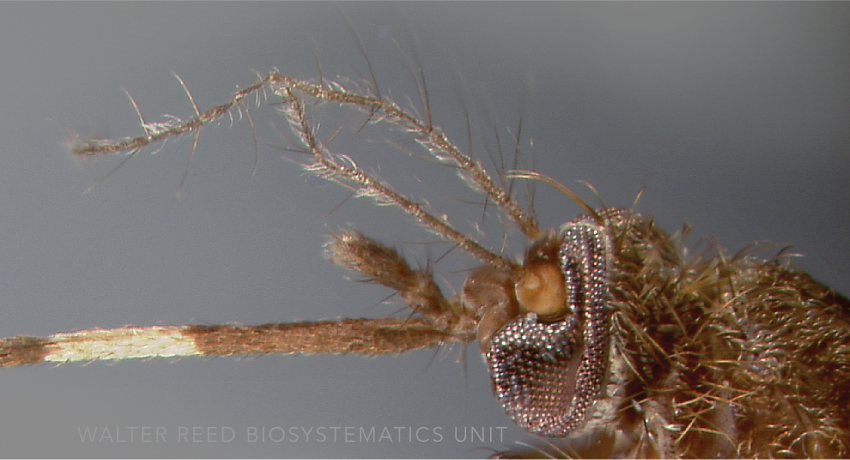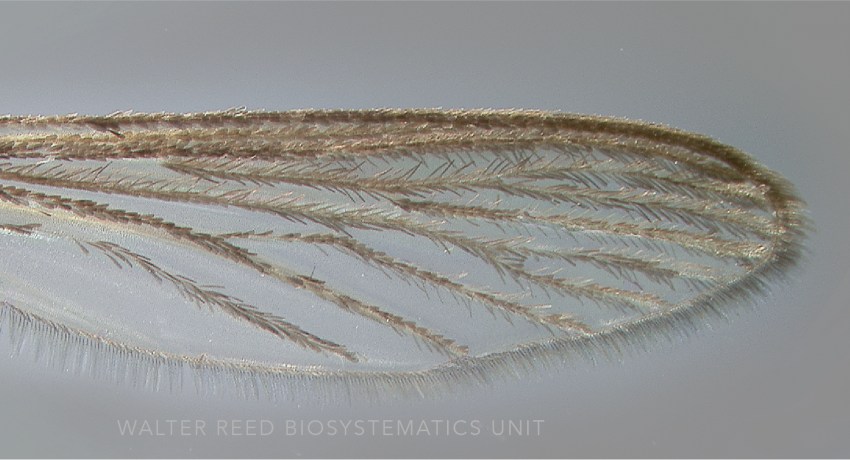AUSTRALIAN, ORIENTAL & PACIFIC REGIONS
Etymology: ringed beak (Latin); proboscis
Culex annulirostris sports a distinctive median pale band on its proboscis and has banded legs. It closely resembles and is sometimes sympatric with Culex sitiens. It is found from Indonesia east to the Southern Pacific Islands, and from Australia north to the Philippines Islands.
Type locality: Blue Mountains & Berowra, New South Wales, Australia
Type depository: Macleay Museum of Natural History, University of Sydney, Sydney, Australia
DIAGNOSTIC CHARACTERS (Click photos to view; mouse over and click large photo to zoom in.)
ADULT (illustrated): Head: Proboscis with median pale band 0.25–0.30 of total length. Thorax: Postspiracular area bare; lower mesepimeral setae absent; abdominal terga pale basally. Abdomen: Abdominal terga pale basally. Wing: Wing all dark-scaled. Legs: Fe-II usually intermixed with pale scales but not forming definite spot; Fe-III usually with some pale scales intermixed with dark.
LARVA (not illustrated): Head: Dorsal apotome distinctly separated from median labral plate; seta 1-C short, stout, apically blunt. Thorax: Setae 1-M,T small. Abdomen: Seta 6-VI double; seta 7-I double. Terminal segments: Comb with scales apically rounded with even fringe of fine spinules; siphon index <6.0; seta 1-S tufts well-developed, 6–12 branched; pecten with spines bearing 8–9 lateral denticles.
TAXONOMIC KEYS
Ramalingam 1976
Lee et al. 1989a
Becker et al. 2010
![]()
WRBU – Culex – Indomalayan Region – Larva
Exemplar DNA sequences
Cx. annulirostris COI: KU494989–95.
BIONOMICS
Immatures
Reported habitats vary widely - immatures are found in urban and rural environments, in full sunlight to heavy shade, in clean or polluted fresh or brackish water. Although ovipositing Cx. annulirostris generally seek out established ground pools with well-developed vegetation, such as rice fields and swamps, they also lay eggs in shallow pools of water with emergent grasses immediately after rains, and in container habitats including cacao shells, bamboo stumps and artificial containers. Under laboratory conditions, females choose black-colored containers with water that is 10 cm deep with conspecific larvae present, indicating that this species is using a combination of visual and chemical cues to choose oviposition sites. The ecological plasticity of this species suggests it may comprise cryptic taxa.
Adults
Across most of their range Culex annulirostris females are active from spring to late autumn. They are multivoltine, which often promotes high population densities and populations are highest when mean temperatures reach 25oC. In Australia, Culex annulirostris is active throughout the year, but are most common between October and May when average daily temperatures rise above 17.5oC. Females feed primarily outdoors in the evening, but have also been reported feeding indoors and during the day. They opportunistically feed on any available mammals, including dogs, cats, brushtail possums, horses, man, birds, cats, and fruit bats. Population-specific host preferences are reported, with some populations preferentially feeding on birds.
DISTRIBUTION NOTES
Australia, Bismarck Archipelago, Cook Islands (Polynesia), Easter Island, Fiji, French Polynesia, Guam, Indonesia, Kiribati, Mariana Islands, Micronesia (Wake Island), Nauru, New Caledonia, Palau, Papua New Guinea, Philippines, Samoa (Ind. State of Samoa; American Samoa; Western Samoa), Solomon Islands, Tahiti, Timor, Tonga, Tuvalu, Vanuatu.

WRBU VECTOR HAZARD REPORTS
None; View other WRBU Vector Hazard Reports
Available GIS Models:
Cx_annulirostris_Nyari_1 Australasia
IMPORTANT REFERENCES (full citations below)
Bancroft 1908: 43 (M, F)
Bohart & Ingram 1946b: 18 (M*, F, L*; bionomics, distribution, taxonomy)
Knight & Hurlbut 1949: 30 (M*, F, P, L*; taxonomy)
Penn 1949b: 81 (P*)
Miller & Phillips 1952: 23 (F*, L*)
Bohart 1957 (1956): 80 (M*, F, L*; distribution; Micronesia)
Belkin 1962: 207 (M*, F, P*, L*)
Dobrotworsky 1965: 207 (M*, F*, L*)
Delfinado 1966a: 139 (M*, F, L*; synonymy)
Basio 1971b: 53 (M*; bionomics)
Baisas 1974: 87 (M*, F*, P, L*)
Baisas 1974: 87 (M*, F*, P, L*; taxonomy, bionomics, distribution; Philippines)
Ramalingam 1976: 308 (taxonomy, bionomics, keys, distribution; Samoa & Tonga)
Sirivanakarn 1976: 107 (M*, F*, P*, L*; distribution)
Kay 1978 (taxonomy)
Marks 1982 (taxonomy)
Russell 1986a (bionomics)
Russell 1987 (bionomics)
Lee et al. 1989a: 36 (F key, taxonomy, bionomics, distribution, review)
Whelan & Hapgood 2000 (bionomics, distribution; East Timor)
Becker et al. 2010: 365 (F*, L*; key, taxonomy, distribution, bionomics)
Jansen et al. 2013 (morphological & DNA identification)
CURRENT SYNONYMS & SUBSPECIES
syn. jepsoni Bahr
1912: 18 (F*). Type locality: Fiji Islands (NHMUK).
syn. somerseti Taylor
1912: 28 (F). Type locality: Somerset, Queensland, Australia (ANIC). References: Lee et al. 1989a: 36 (type information).
syn. consimilis Taylor
1913: 55 [alternate pub. p. 8] (M*, F; Culicelsa). Type locality: Ayr, Queensland, Australia (ANIC). References: Lee et al. 1989a: 36 (type information).
syn. simplex Taylor
1914c: 698 (F*; Culicelsa). Type locality: Townsville, Queensland, Australia (ANIC).
syn. palmi Baisas
1938: 207 (M*, F*, P*, L). Type locality: Paranaque, Rizal, Luzon, Philippines (NE). References: Lee et al. 1989a: 36 (type information).
ssp. marianae Bohart & Ingram
1946b: 42 (M*, L*; bionomics, distribution, taxonomy.). Type locality: Cheran Konoa, Saipan, Mariana Islands (USNM). Distribution: Mariana Islands. References: Bohart & Ingram 1946b: 32 (M*, L*; ssp. marianae; bionomics., distribution); Yamaguti & LaCasse 1950a: 18 (M*, F*, P*, L*). Etymology: Marianas Is. Informal name: Saipan Mariana Islander Typical Mosquito.
CITED REFERENCES
Bahr, P. H. (1912). Filariasis and elephantiasis in Fiji; being a report to the London School of Tropical Medicine. Journal of the London School of Tropical Medicine, Supplement 1, 1–192.
Baisas, F. E. (1938). Notes on Philippine mosquitoes. VII. A. Culex (Culex) with banded proboscis and tarsi. B. Anopheles: the pupae of three rare species; the Leucosphyrus-subgroup. Monthly Bulletin of the Bureau of Health, 18(5), 175–232.
Baisas, F. E. (1974). The mosquito fauna of Subic Bay Naval Reservation, Republic of the Philippines. San Francisco: Headquarters, First Medical Service Wing (PACAF), San Francisco.
Bancroft, T. L. (1908). List of the mosquitoes of Queensland, with the original descriptions and notes on the life-history of a number. Annals of the Queensland Museum, 8, 1–64.
Basio, R. G. (1971b). The mosquito fauna of the Philippines (Diptera, Culicidae). Manila: National Museum of the Philippines. 198pp.
Becker, N., Petrić, D., Zgomba, M., Boase, C., Madon, M., Dahl, C., & Kaiser, A. (2010). Mosquitoes and their control (Second ed.). Berlin Heidelberg: Springer-Verlag.
Belkin, J.N. (1962). The mosquitoes of the South Pacific (Diptera, Culicidae) (Vols. 1 &2). Berkeley, California: University of California Press.
Bohart, R.M. (1957). Insects of Micronesia (Diptera: Culicidae) (Vol. 12). Honolulu, Hawaii Bishop Museum, Honolulu.
Bohart, R.M., & Ingram, R.L. (1946b). Mosquitoes of Okinawa and islands in the Central Pacific. In United States NAVMED (Bureau of Medicine and Surgery, Navy Department) (pp. 110). Washington.
Delfinado, M.D. (1966a). The culicine mosquitoes of the Philippines, tribe Culicini (Diptera, Culicidae). Memoirs of the American Entomological Institute, 7, 1–252.
Dobrotworsky, N.V. (1965). The mosquitoes of Victoria (Diptera, Culicidae). London and New York.
Jansen, C.C., Hemmerter, S., van den Hurk, A.F., Whelan, P.I., & Beebe, N.W. (2013). Morphological versus molecular identification of Culex annulirostris Skuse and Culex palpalis Taylor: key members of the Culex sitiens (Diptera: Culicidae) subgroup in Australasia. Australian Journal of Entomology, 52(4), 356–362.
Kay, B.H. (1978). Variation in the abdominal sternal banding of Culex annulirostris Skuse (Diptera: Culicidae). Journal of the Australian Entomological Society, 17, 311–315.
Knight, K.L., & Hurlbut, H.S. (1949). The mosquitoes of Ponape Island, eastern Carolinas. Journal of the Washington Academy of Sciences, 39, 20–34.
Lee, D.J., Hicks, M.M., Debenham, M.L., Griffiths, M., Marks, E.N., Bryan, J.H., & Russell, R.C. (1989a). The Culicidae of the Australasian region. Volume 7. Commonwealth Department of Health, School of Public Health and Tropical Medicine Monograph Series, 2.
Marks, E.N. (1982). Recent taxonomic studies of Culex annulirostris and allied species and their possible significance for arbovirus research. Arbovirus Research in Australia, 146–151.
Miller, D., & Phillips, W. J. (1952). Identification of New Zealand Mosquitoes. [Issued by the New Zealand Department of Health, Nelson, Cawthron Institute. 28pp.
Penn, G.H. (1949b). The pupae of the mosquitoes of New Guinea. Pacific Science, 3, 3–85.
Ramalingam, S. (1976). An annotated checklist and keys to the mosquitoes of Samoa and Tonga. Mosquito Systematics, 8(3), 298–318.
Russell, R.C. (1986a). Culex annulirostris Skuse (Diptera: Culicidae) at Appin, N.S.W. - Bionomics and behaviour. Journal of the Australian Entomological Society, 25(2), 103–109.
Russell, R.C. (1987). Age composition and overwintering of Culex annulirostris Skuse (Diptera: Culicidae) near Deniliquin, in the Murray Valley of New South Wales. Journal of the Australian Entomological Society, 26(1), 93–96.
Sirivanakarn, S. (1976). Medical entomology studies - III. A revision of the subgenus Culex in the Oriental region (Diptera: Culicidae). Contributions of the American Entomological Institute, 12(2), 1–272.
Taylor, F.H. (1912a). Description of mosquitoes collected in the Northern Territory during the expedition, 1911. Bulletin of the Northern Territory of Australia, 1a, 25–34.
Taylor, F.H. (1912b). Contribution of a knowledge of the Culicidae and Ixodidea of North Queensland and the Torres Straits. Retrieved from Queensland: pp 27–29
Taylor, F.H. (1913). Report of the entomologist. Report of the Australian Institute of Tropical Medicine, 1911, 49–74.
Taylor, F.H. (1914c). The Culicidae of Australia. I. Transactions of the Entomological Society of London, 683–708.
Whelan, P., & Hapgood, G. (2000). A mosquito survey of Dili, East Timor, and implications for disease control. Arbovirus Research in Australia, 8, 405–416.
CITE THIS PAGE
Walter Reed Biosystematics Unit (Year). Culex annulirostris species page. Walter Reed Biosystematics Unit Website, http://wrbu.si.edu/vectorspecies/mosquitoes/annulirostris, accessed on [date (e.g. 03 February 2020) when you last viewed the site].










































































































































































